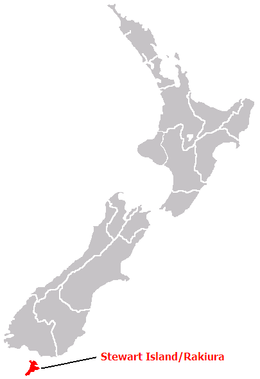Stewart Island, New Zealand
| Rakiura (Māori) | |
|---|---|

Map of Stewart Island/Rakiura
|
|

Location of Stewart Island/Rakiura
|
|
| Geography | |
| Location | Foveaux Strait |
| Coordinates | 47°00′S 167°50′E / 47.00°S 167.84°ECoordinates: 47°00′S 167°50′E / 47.00°S 167.84°E |
| Archipelago | New Zealand archipelago |
| Major islands | Anchorage Island, Bench Island, Codfish Island, Native Island, Noble Island, Pearl Island, Titi/Muttonbird Islands, Ulva Island |
| Area | 1,746 km2 (674 sq mi) |
| Highest elevation | 980 m (3,220 ft) |
| Highest point | Mount Anglem |
| Administration | |
| Regional Council | Southland |
| Largest settlement | Oban (pop. 322) |
| Demographics | |
| Population | 381 (2013) |
| Pop. density | 0.22 /km2 (0.57 /sq mi) |
Stewart Island/Rakiura (commonly called Stewart Island) is the third-largest island of New Zealand. It lies 30 kilometres (19 mi) south of the South Island, across the Foveaux Strait. Its permanent population is 381 people as of the 2013 census, most of whom live in the settlement of Oban on the eastern side of the island.
The original Māori name, Te Punga o Te Waka a Maui, positions Stewart Island/Rakiura firmly at the heart of Māori mythology. Translated as The Anchor Stone of Maui’s Canoe, it refers to the part played by the island in the legend of Maui and his crew, who from their canoe, the South Island, caught and raised the great fish, the North Island.
Rakiura is the more commonly known and used Māori name. It is usually translated as Glowing Skies, possibly a reference to the sunsets for which it is famous or for the aurora australis, the southern lights that are a phenomenon of southern latitudes.
For some, Rakiura is the abbreviated version of Te Rakiura a Te Rakitamau, translated as "great blush of Rakitamau", in reference to the latter's embarrassment when refused the hand in marriage of not one, but two daughters, of an island chief. According to Māori legend, a chief on the island named Te Rakitamau was married to a young woman who became terminally ill and implored him to marry her cousin after she died. Te Rakitamau paddled across Te Moana Tapokopoko a Tawhiki (Foveaux Strait) to the South Island where the cousin lived, only to discover she had recently married. He blushed with embarrassment; so the island was called Te Ura o Te Rakitamau.
Captain James Cook and his crew were the first Europeans to sight the island, in 1770, but Cook thought it was part of the South Island so named it South Cape. The island received its English name in honour of William W. Stewart, who was first officer on the ship Pegasus, which visited from Port Jackson (Sydney), Australia, in 1809 on a sealing expedition. Stewart charted the large southeastern harbour that now bears the ship's name (Port Pegasus), and determined the northern points of the island, proving that it was an island. He made three further visits to the island from the 1820s to the 1840s.
...
Wikipedia
